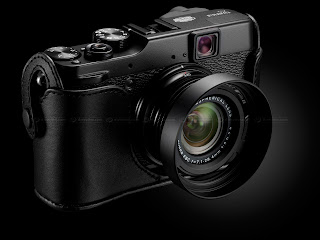It's been quite a while since I've posted anything and wouldn't you know that inspiration would be found in my penchant for conspicuous consumerism? Way back in March of 2010, I praised (in more detail than any but the most rabid of photographers would appreciate) the joys of rangefinder cameras. I won't bore you with a re-hash of that post, but am compelled to say that in retrospect, my purchase of the Panasonic GF1 while motivated by the similarities (at least in appearance) to the rangefinders of old, was totally misguided. In truth, the GF1 is a digital camera with a similar body style that offers interchangeable lenses, but in action, it does not possess enough of the rangefinder's DNA to qualify as a modern-day substitute.
I refer you once again to the photo below to clarify.
The key feature of a rangefinder camera is the optical viewfinder in the upper right-hand corner of the camera (a Leica M3) displayed above. While single-lens-reflex cameras became the eventual standard for news photographers, sports photographers and consumers in the late 60s and early 70s, the blessing and curse of this design is that at the precise moment of exposure, the mirror that allows the photographer to see through the lens that is capturing the image, flips up to totally obscure the viewfinder.
The rangefinder on the other hand, offers a clear view of the framed subject at all times since the viewfinder is simply a "window," clear glass if you will. In a sense, with SLR cameras, the decisive moment becomes the indecisive moment as you may or may not have captured what you intended. True, the digital cameras of today offer almost instantaneous feedback, but to the PURIST, in the spirit of a rangefinder camera, the decisive moment is still the moment when you depress the shutter release button as you compose through the viewfinder. (OK, OK, some of today's digital cameras offer electronic viewfinders eliminating the blackout problem, but the view is propagated by a micro-miniature television screen which makes it somehow offensive to technophobes such as myself). And so in an attempt to right my past wrong, I have recently purchased the new Fujifilm X10.
The first thing you should notice, now that you've been trained to spot rangefinder cameras, is the optical viewfinder just to the right and above the lens. It is this one key important feature that qualifies the X10 as a modern-day rangefinder and one that is lacking on almost every digital camera today. Sadly, the display on the back of these cameras has become de riguer these days. Cameras should not be held away from you, they should be snuggled against your face(which incidentally, helps steady the camera in a way not achieved otherwise).
And similar to the classic rangefinders, this camera sports a vast array of manual controls, those things called knobs and dials that have somehow been eliminated with touchscreens. You actually have to twist the lens to zoom in and out rather than push a lever that actuates a motorized zoom lens. How innovative is that? I suppose I'm betraying my reactionary ways here, but you should know I was "classically trained" as a photographer. Cameras were mechanical marvels back then, operated by gears and intricate internal mechanisms that coalesced in a perfect symphony of movement to adjust the lens opening, the shutter speed and align the film in the proper spot to capture a moment of time. Somehow the decisive click and tactile feedback of the shutter mechanism of those cameras proved to be immensely satisfying, unlike the electronic beep or simulated shutter sounds of today's devices. Yes there are more electronic parts than mechanical ones in the Fuji X10, and yes, it is a digital camera. But, Fuji has incorporated the interface and operation of those old rangefinder cameras in its latest model. There is a reassuring feel and look of a camera once more versus the evolving face of digital image capture devices (have you seen the Lytro?) I can return to my roots with this camera, back when I was first inspired to create images. Remarkably, I've found the "fun" again in shooting photos.


No comments:
Post a Comment